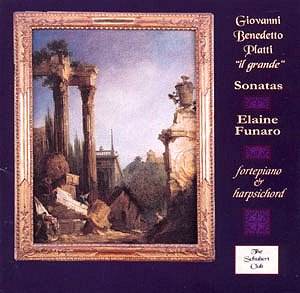Italian-born Giovanni Benedetto Platti moved to Germany
at the age of 25, where he became a member of the court chapel of Fürstbischof
Johann von Schönborn. He did not write a great deal of music -
some harpsichord concertos, flute concertos, harpsichord sonatas and
vocal works. This disc features a selection of his harpsichord sonatas,
played on both harpsichord and fortepiano.
These works come from a period when new trends were
appearing in keyboard music. Coming from Italy in the 1730s and 1740s,
this music featured vocally-based melodies, with question and answer
phrases, and a closer attention to feelings and sentiments. All the
sonatas here are in the Italian sonata form - that is, three or four
movements, typically marked allegro, adagio, and allegro, or adagio,
allegro, adagio, allegro - as opposed to that which Bach used most often,
the partita form, which featured a series of dance movements.
Platti’s music is closer to that of C.P.E. Bach than
Johann Sebastian Bach, even though he was a contemporary of ‘Old’ Bach.
One can hear the similar structures and the way that Platti builds his
melodic material is similar to C.P.E. Bach’s style of using binary movements
with distinct question and answer sections. At times, such as in the
opening adagio of the 7th sonata, one marvels at the subtlety of the
melodies and their progression; the music almost sounds improvised.
Yet in other works, one is made to think of Scarlatti, such as in the
rousing opening adagio of the 1st sonata, with its movement up and down
the keyboard, or the quirky intervals of the third movement of the 3rd
sonata. The opening of the 9th sonata sounds almost Mozartian in its
simplicity, and other movements hint at similar musical material.
But the real stars of this disc - other than Elaine
Funaro, who approaches this music with energy and vigour, making it
sound above all fun - are the instruments used. A beautiful sounding
fortepiano, with a lush, round sound, is used for the first two and
last two sonatas. This instrument has an action "that can be shifted
so that the hammers strike only one of the two strings for every note".
This gives it a subtle, light tone, which is unique. The brass-strung
harpsichord used for the other four sonatas is also a wonderful instrument,
with a full, deep sound, though it suffers from a bit too much reverb
in the recording.
Listening to this disc, I was drawn into the playful,
enjoyable sound of the music, and the attention to detail that Elaine
Funaro brings to this recording. Having never heard Platti’s works before,
I was delighted to discover a little-known composer interpreted with
gusto and verve. This fine recording is excellent for its music, performance
and instruments.
Kirk McElhearn

![]() Elaine Funaro, fortepiano
* and harpsichord **
Elaine Funaro, fortepiano
* and harpsichord ** ![]() WILDBOAR WLBR 9901 [77.20]
WILDBOAR WLBR 9901 [77.20]